
Gray Treefrog
It is a rainy night in early summer. In the distance, one can faintly make out some unusual sounds. Drawing closer, the sounds become louder until the chorus is nearly deafening! The small wetland you stand along seems as though it should be infested with the owners of these voices but, scour though you may, there is not a creature to be found! This was exactly my experience amidst hundreds of perfectly-concealed gray treefrogs. The only reason I was so fortunate as to meet this vocal fellow was thanks to his choice of such an exposed perch. Lake Lure, NC.
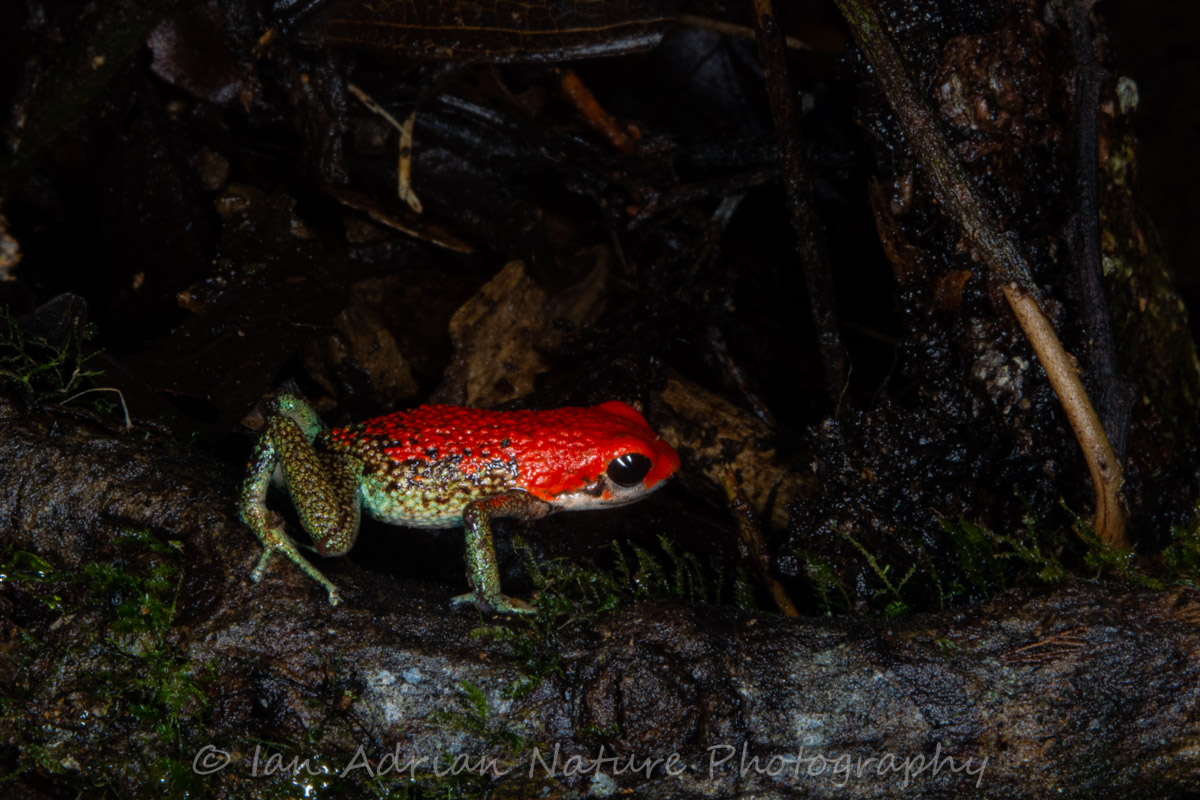
Granular Dart Frog
Despite their abundance in such areas as Southern Costa Rica's Osa Peninsula, granulated dart frogs are considered a species of concern. Their range is quite small, so the tiniest disruption could translate to a disappearance of these magnificent mosquito and gnat-eaters. We must learn how to treat this planet kinder and protect all the unique species with whom we share the land. Dos Brazos, Costa Rica.

Canyon Camouflage
Like many reptiles and amphibians, canyon treefrogs become lighter in coloration as their cold-blooded bodies warm up. Darker or lighter, they blend in perfectly with the granite cliffs the frogs call "home." Catalina Mountains, AZ.
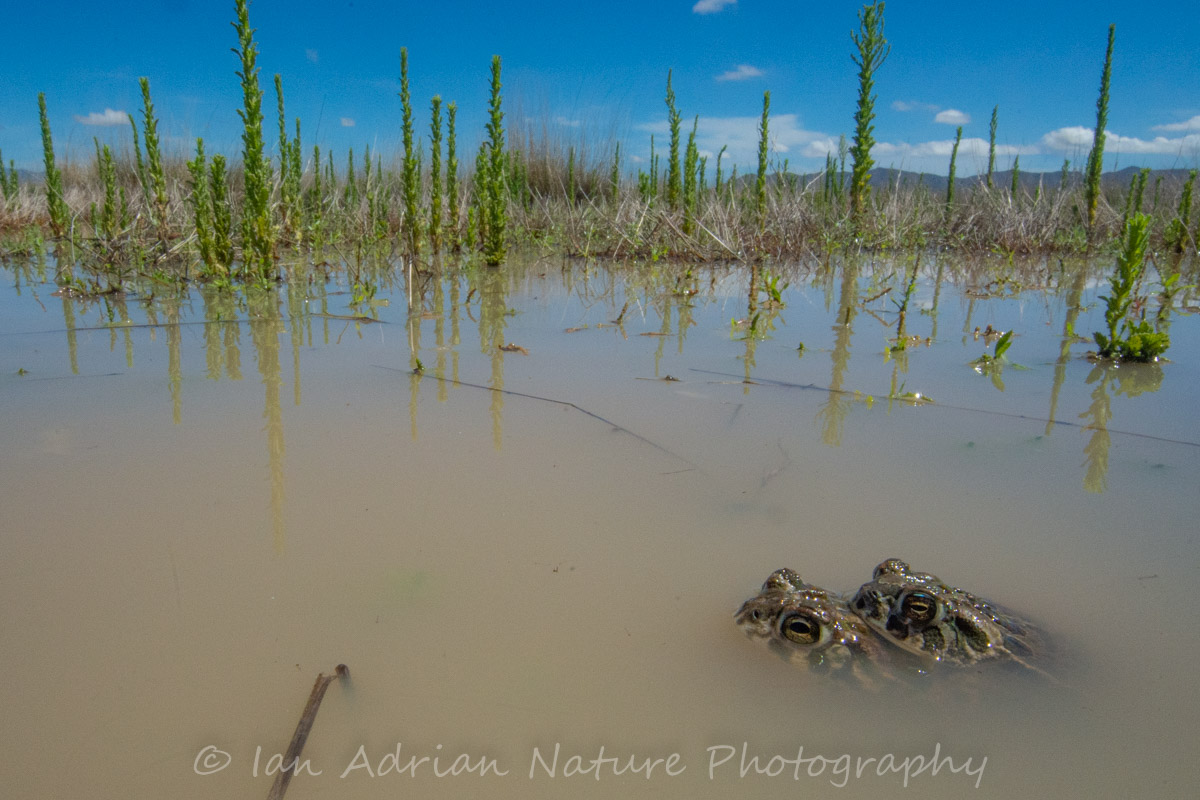
Tickled Toads
As monsoon thunderstorms saturate the land with life-sustaining moisture, love soon enters the minds of Arizona's amphibians. Moisture fuels plant growth, in turn feeding insects, translating to food and water for the amphibians to eat and reproduce. Not unlike Tucson's human inhabitants, the wildlife celebrates life yet again returning to our Sonoran Desert. Willcox, AZ.

Tenacious Treefrogs
When a male canyon treefrog wishes to attract a lady, standard protocol involves choosing an appealing spot in the shallows and calling furiously in the hope of being heard over all the other horny males. When there's another fellow right next door giving your shouts a run for their money, however, eviction is a perfectly acceptable alternative. Every time bottom frog bleated (their calls rather resemble a sheep), top frog would jump on him and try to silence this competitor. Catalina Mountains, AZ. Prints of this image are not currently available for sale. Please check back!
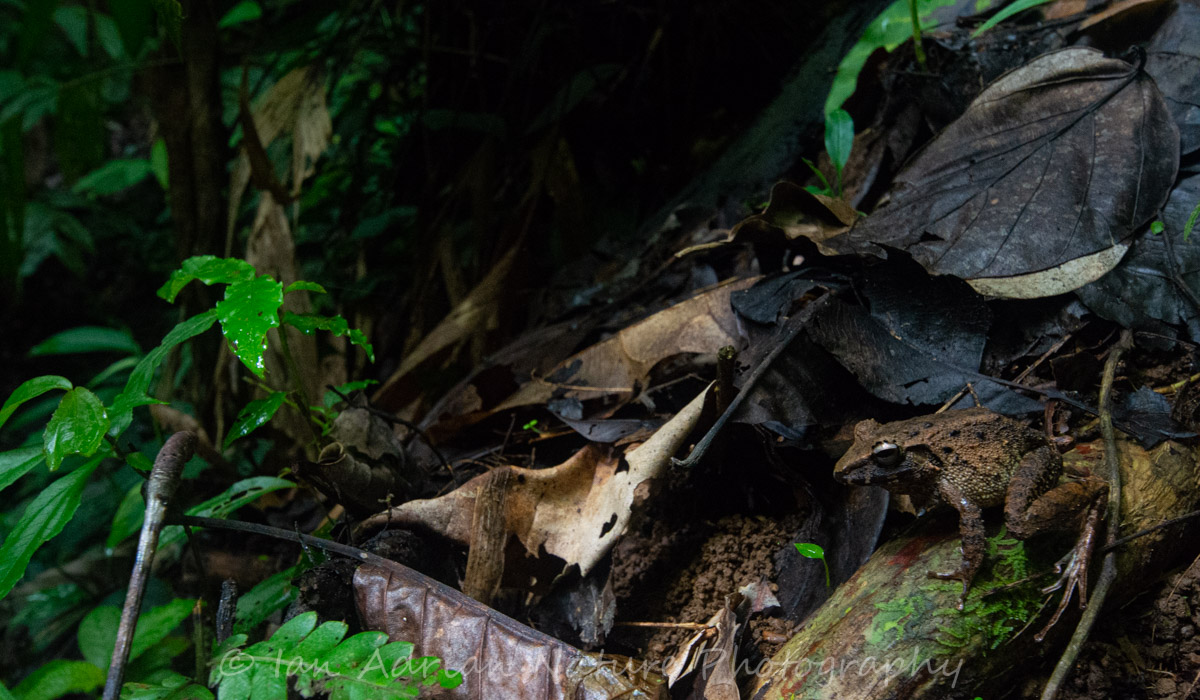
Rainforest Rana
"Rana" is the Spanish word for frogs and toad. This well-camouflaged frog was sitting in plain sight along the trail, yet nearly invisible within the dark jungle. Species unknown. Dos Brazos, Costa Rica.

Mexican Spadefoot
A young Mexican spadefoot toad shows off a single beautiful eye. Spadefoot toads spend most of their lives underground, buried deep in sandy soil. The heavy monsoon rains of summer trigger a mass emergence.
Some areas will become downright littered with spadefoots, eager to breed, stuff their tiny faces, then return underground as the monsoons subside.
Willcox, AZ.
Purchase This Print
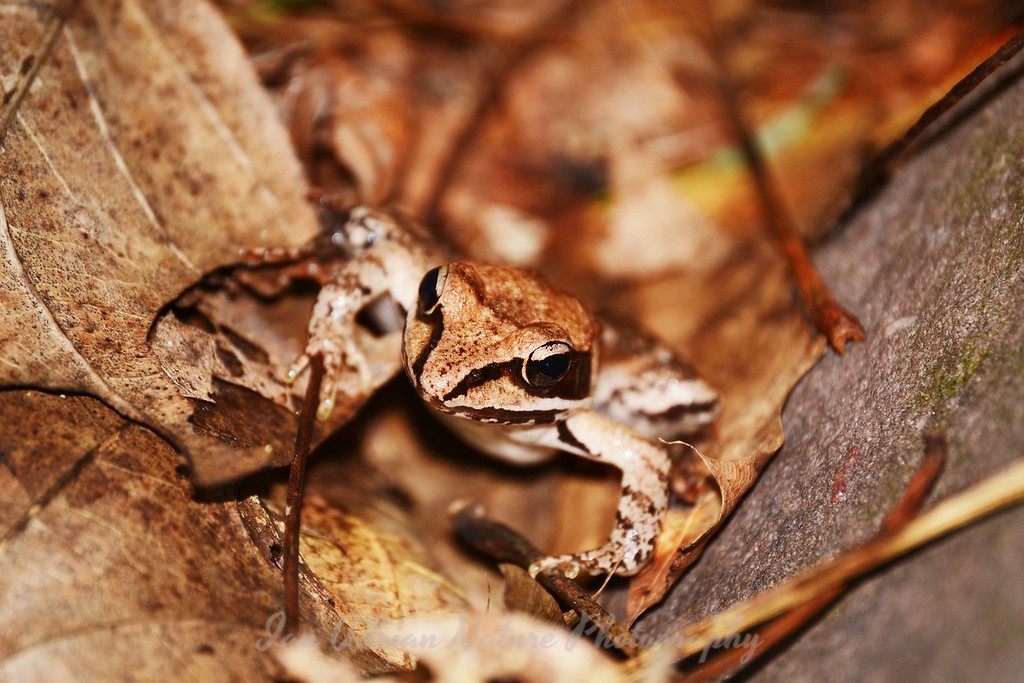
Wood Frog
A young wood frog, well camouflaged in his/her woodland habitat. Wood frogs are likely the most cold-tolerant of all frogs. High amounts of glucose in their blood act as antifreeze. The frog can be almost entirely frozen, but will thaw out in perfect health come springtime, provided their little hearts remain beating until then.
Photographed in Bald Eagle State Forest, PA, USA.
Purchase This Print
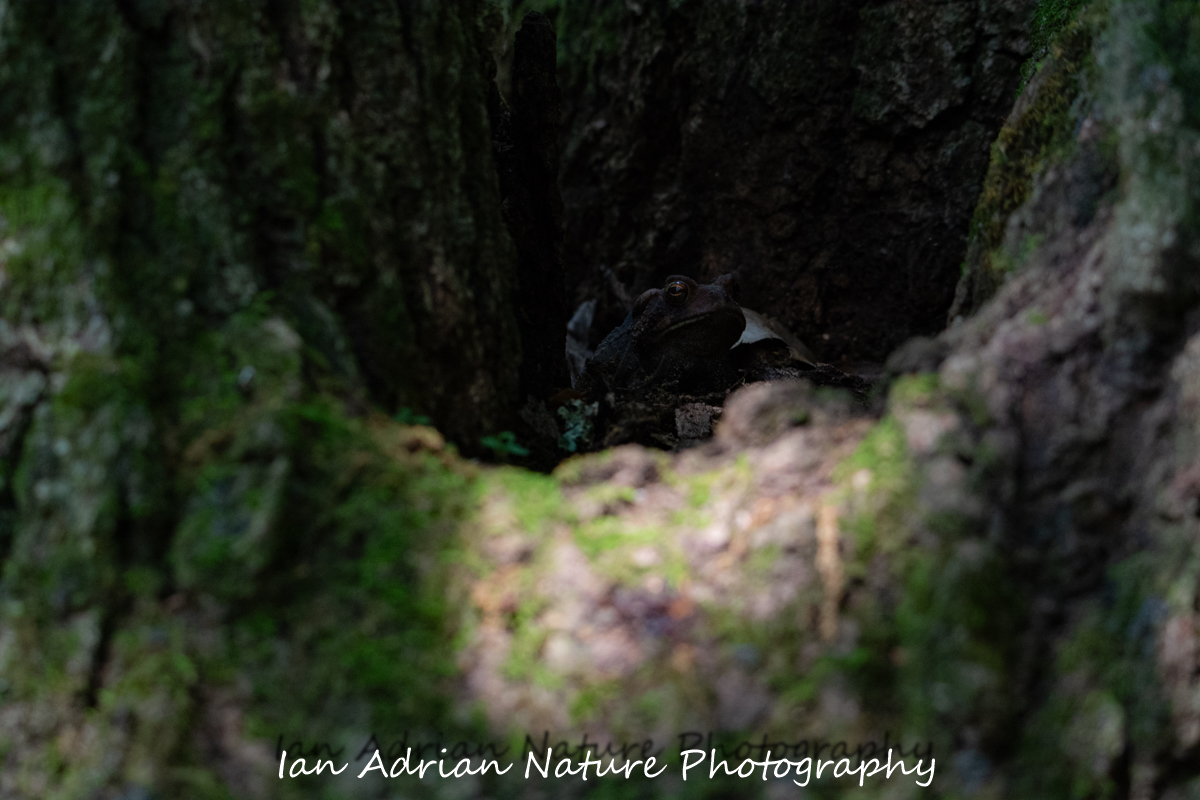
Toad Tree
Just a foot off the ground, an American toad lurks, concealed in his roomy tree house. Gerton, NC.
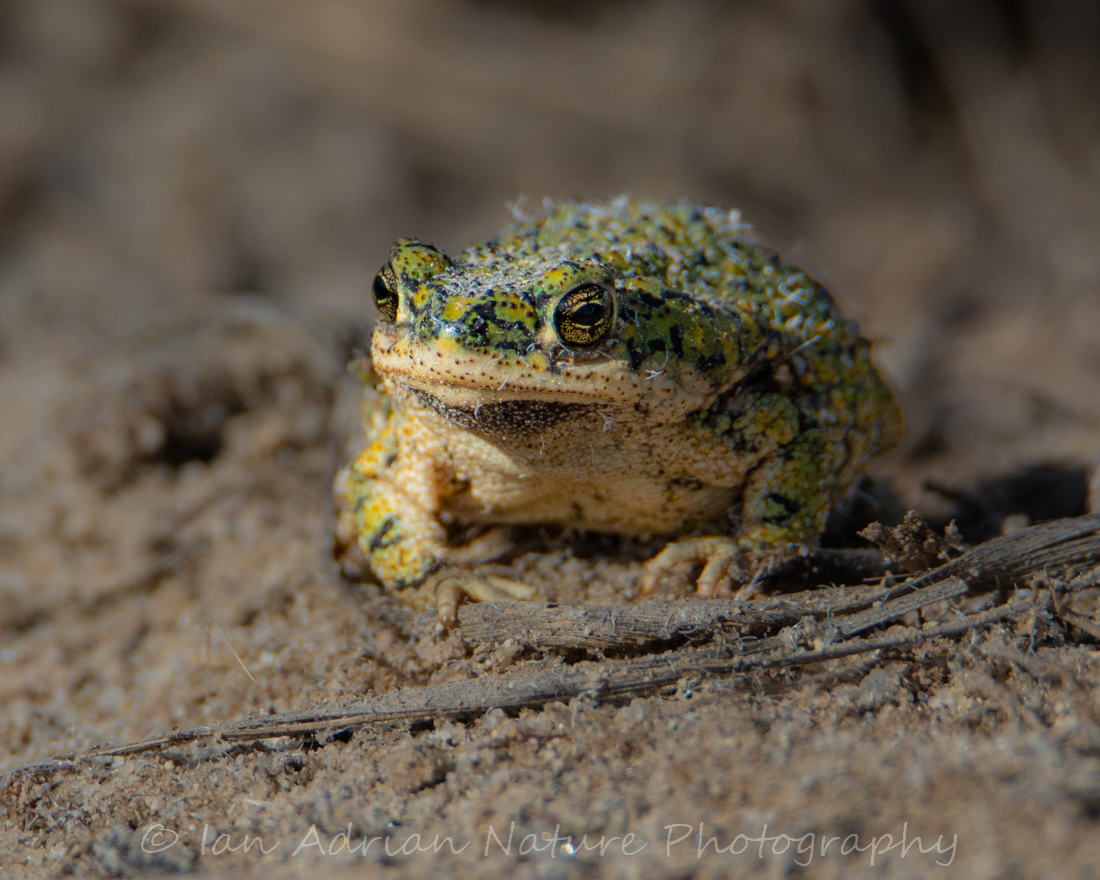
Green Toad
Plenty of mysterious Southwestern species only show themselves during the summer monsoons. The beautiful, petite, green toad is one such amphibian. By the time the monsoon moisture has dried up, these handsome saurians will yet again vanish. Willcox, AZ.

Red-Spotted Toad
Here is a lovely, eye-level perspective of a red-spotted toad. Despite their name, the red spots are often not so conspicuous! He / she hopped off immediately after this picture was snapped.
Chiricahua Nat Monument, AZ.
Purchase This Print
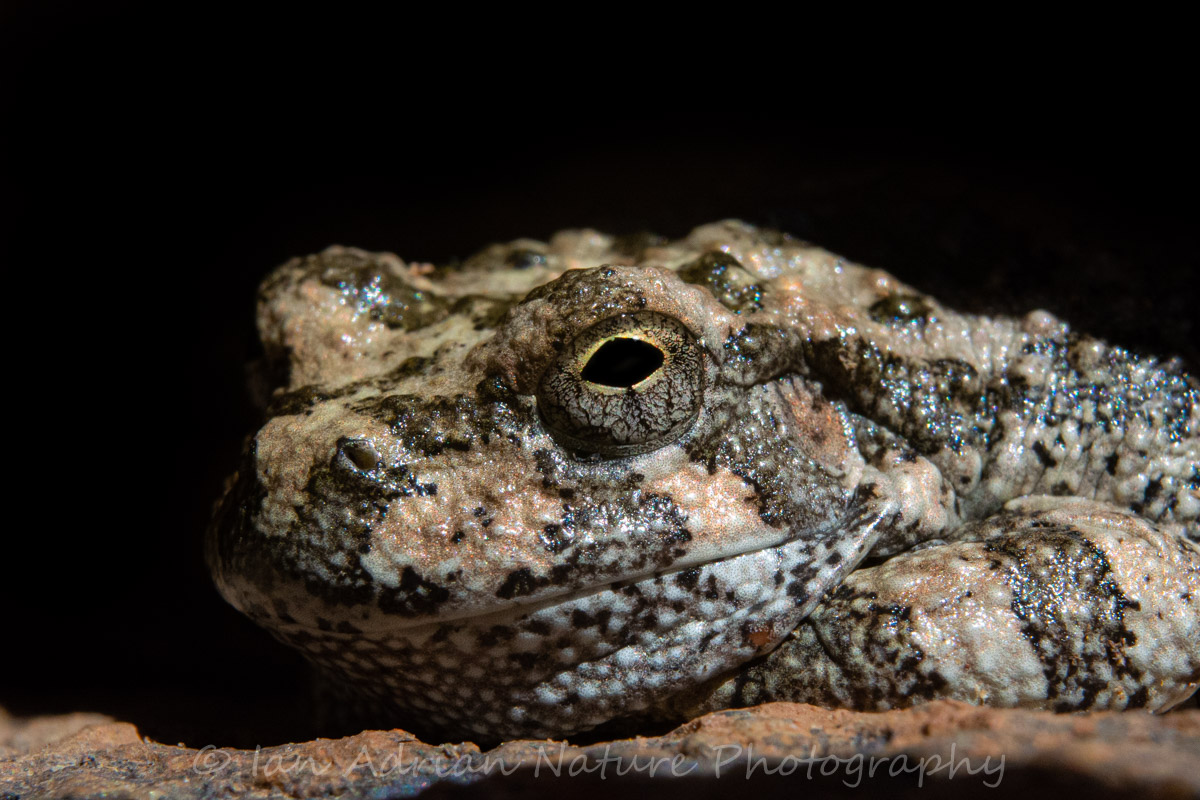
Canyon Treefrog
Unlike most other amphibians, canyon treefrogs actually thrive in hot, dry conditions. They will emerge to bask in the morning and slowly retreat into rocky crevices as the sun scorches their stony abodes. Despite their hefty heat tolerance, they will gather in rather chilly pools to court and make babies. Catalina Mountains, AZ. Prints of this image are not currently available for sale. Please check back!
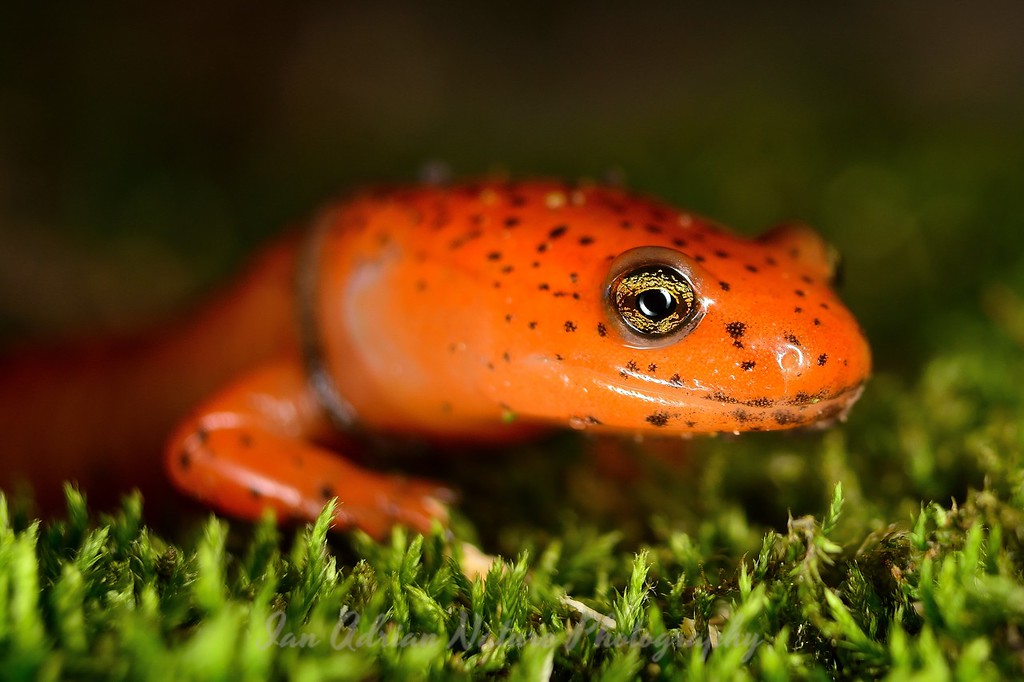
Red Salamander
This eastern red salamander was all-smiles about having his/her picture taken. Photo taken in Winfield, PA, USA.
Purchase This Print

Basking Bullfrog
A very large American Bullfrog, pictured basking over the murky, vegetated waters of his / her swampy home. Bullfrogs are considered the largest frogs in North America. Their gargantuan size sometimes allows for the consumption of fish, other frogs, and even small snakes!
Photo taken in Harrisburg, PA, USA.
Purchase This Print
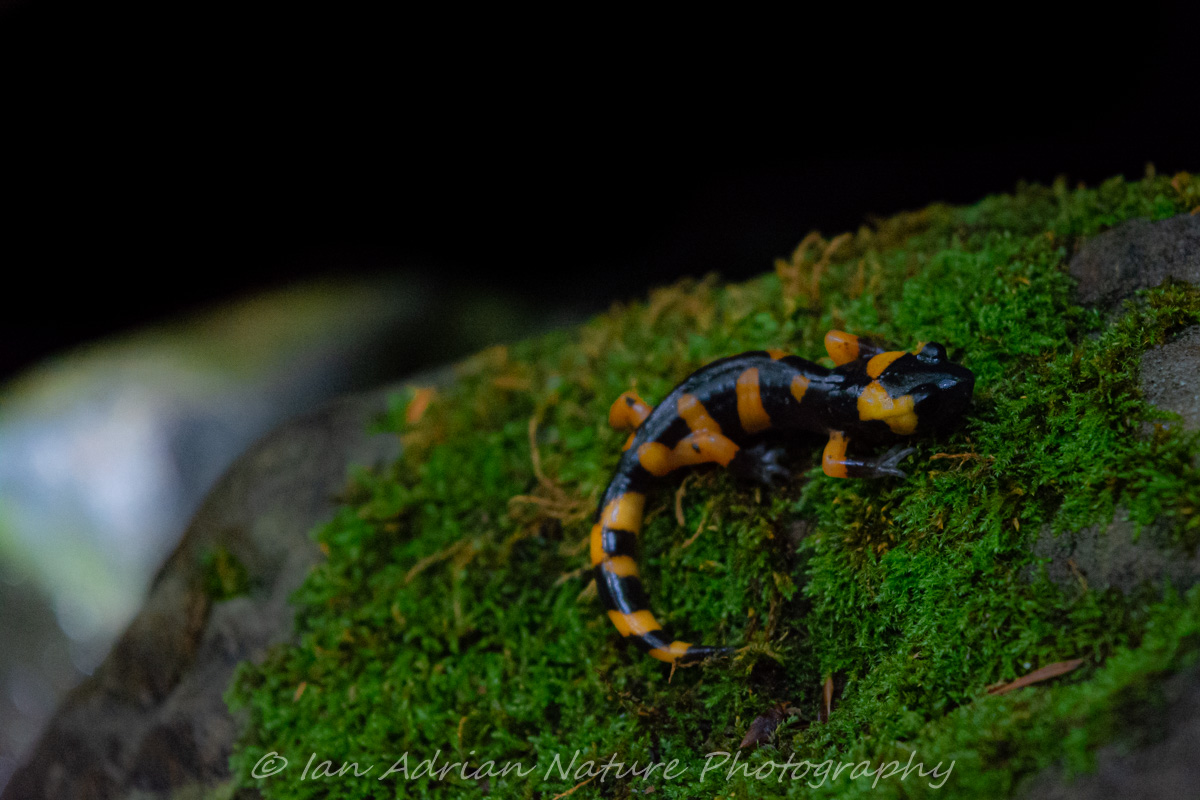
Blotched Ensatina
This blotched ensatina looked stunning amidst the shadowy background and mossy carpet. Back in the 80's, a well-intentioned fellow, fearing the extinction of this beautiful species, captured over 100. He drove to a perfect habitat for them, deep in Arizona's Tonto National Forest, and proceeded to release these precious little salamanders. This bold move risked outcompeting other species, spreading disease, or simply further depleting a population he was already concerned about. Interestingly, they reproduced within a very isolated area and have since thrived without appearing to have had any negative impact on the ecosystem. Encountering several was an absolute joy!
Tonto Nat Forest, AZ.
Purchase This Print

Lurker
Attempting to camouflage from both predator and prey alike, an American Bullfrog lurks amidst the heavy duckweed. Bullfrogs are considered the largest frogs in North America. Their gargantuan size sometimes allows for the consumption of fish, other frogs, and even small snakes!
Photo taken near Harrisburg, PA, USA.
Purchase This Print
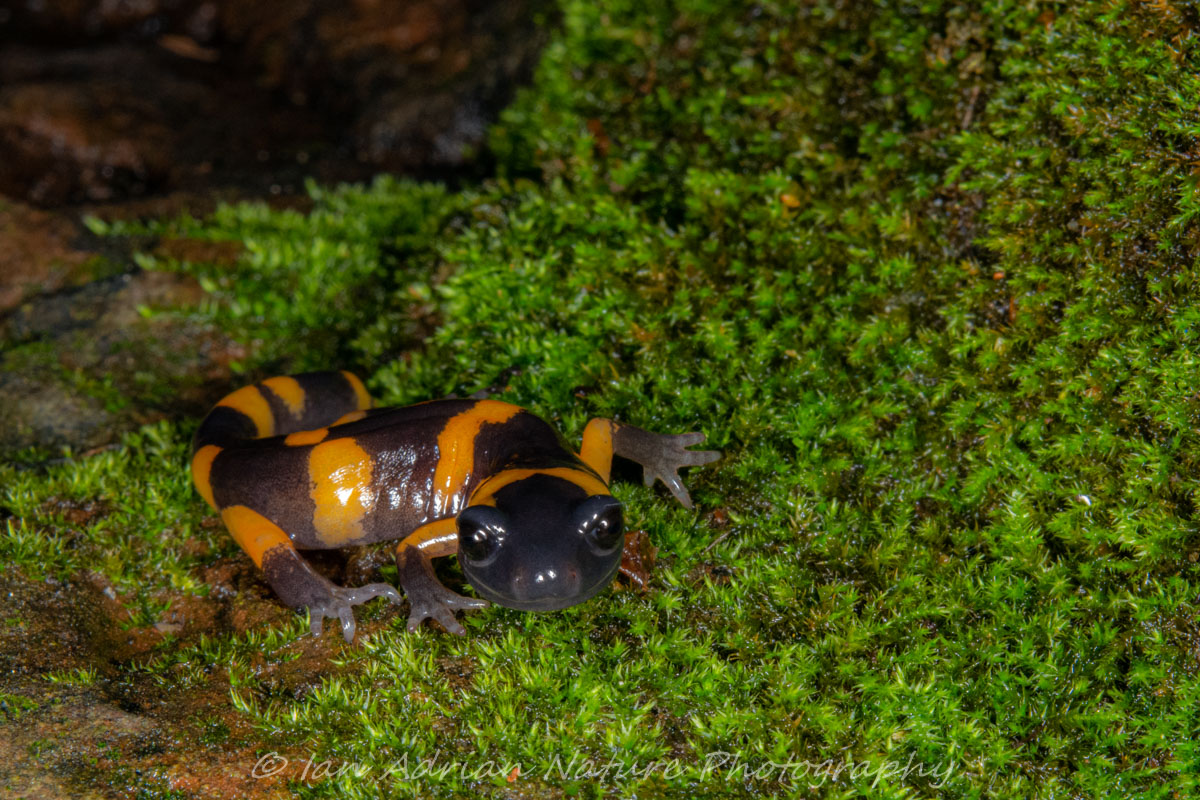
The Face of a Salamander
A yellow-blotched ensatina stares straight at the camera. These small salamanders were surprisingly photogenic! Tonto Nat Forest, AZ. Prints of this image are not currently available for sale. Please check back for future availability!
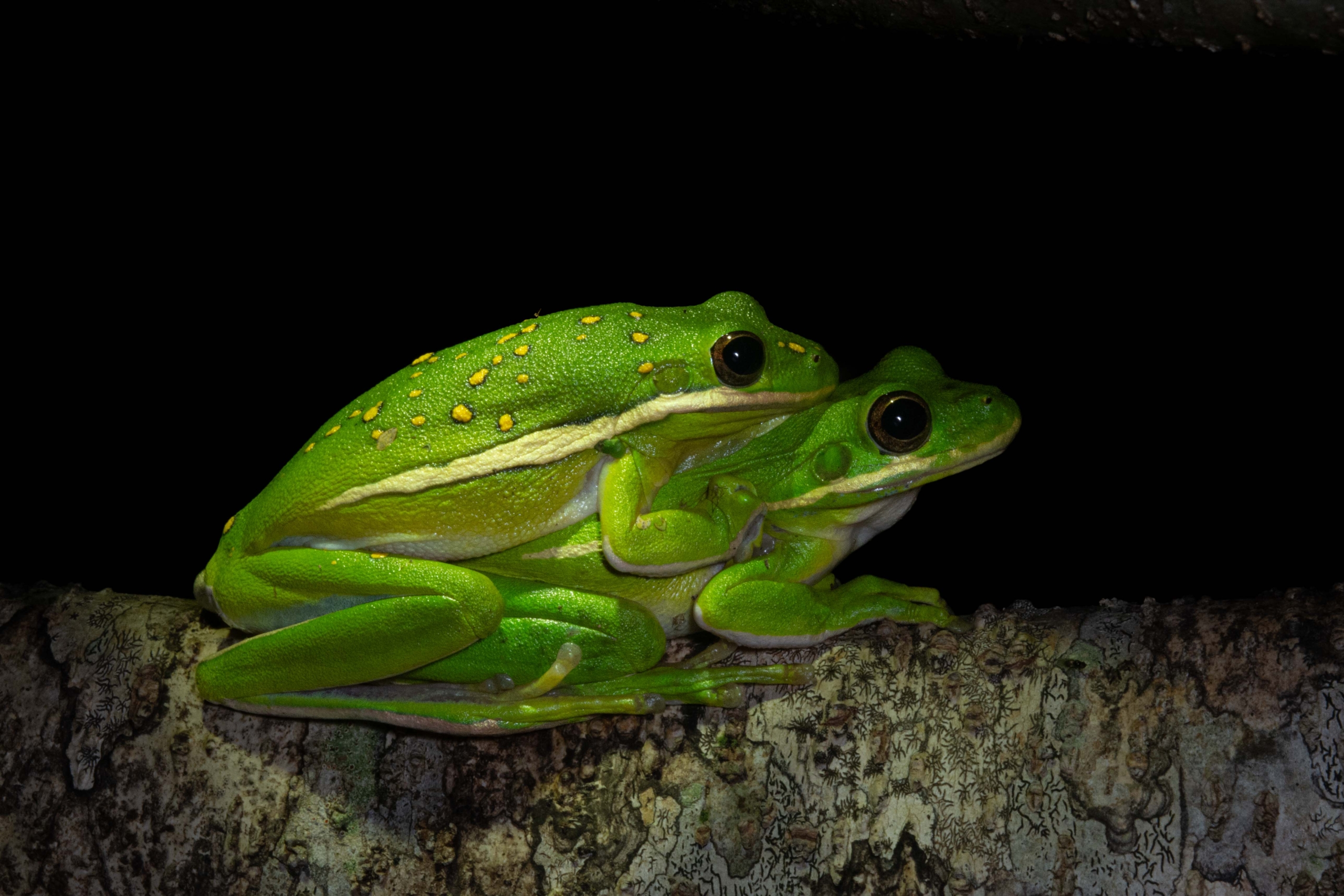
Tickled Treefrogs
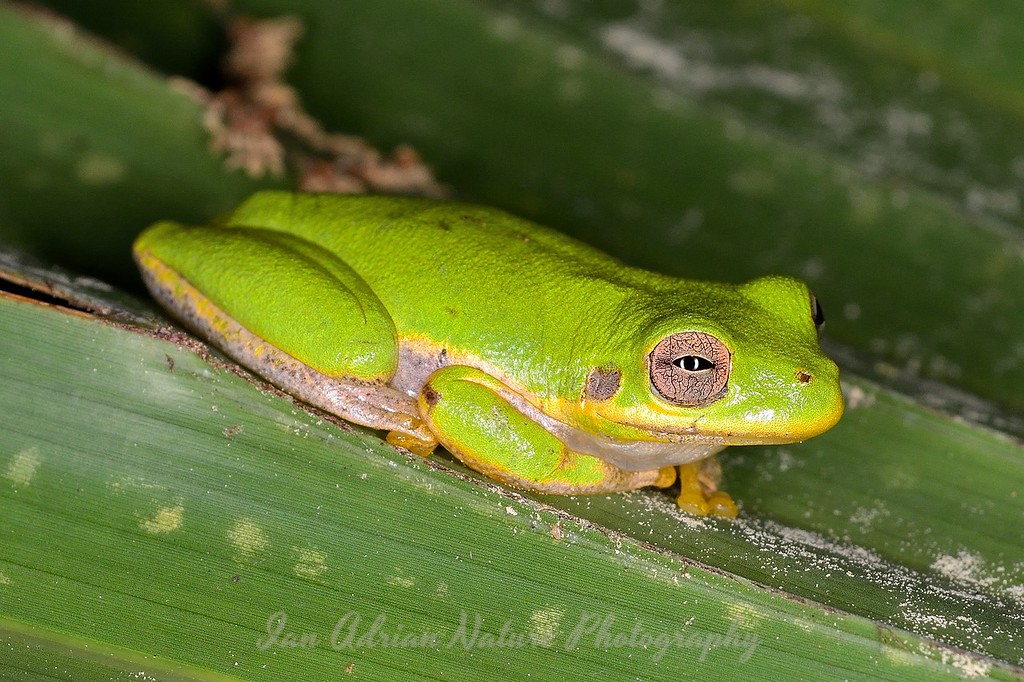
Tiny treefrog
This young green treefrog was barely over an inch long, and I discovered him/her sitting on a palmetto at the edge of my campsite. Like other treefrogs, the green variety are wonderful mosquito control!
The deet-based repellants, although effective at keeping the blood-suckers away, actually kill amphibians on contact. Please, instead, consider using a natural repellant such as lemongrass. Photo taken at Stephen Foster State Park, GA, USA.
Purchase This Print

Green Treefrog

Newt Under Tumbling Waters
While hiking at Rickett's Glen State Park on a visit to my Pennsylvania homeland, I opted to walk beneath on overhanging waterfall. This red eft had the same idea. Between the endless water splatters on the camera lens, the jittery personality of this newt, and the long exposure to capture the water, this may have been the most difficult shot I've ever taken. Prints of this image are not currently available for sale. Please check back for future availability!

Gray Treefrog
It is a rainy night in early summer. In the distance, one can faintly make out some unusual sounds. Drawing closer, the sounds become louder until the chorus is nearly deafening! The small wetland you stand along seems as though it should be infested with the owners of these voices but, scour though you may, there is not a creature to be found! This was exactly my experience amidst hundreds of perfectly-concealed gray treefrogs. The only reason I was so fortunate as to meet this vocal fellow was thanks to his choice of such an exposed perch. Lake Lure, NC.

Granular Dart Frog
Despite their abundance in such areas as Southern Costa Rica's Osa Peninsula, granulated dart frogs are considered a species of concern. Their range is quite small, so the tiniest disruption could translate to a disappearance of these magnificent mosquito and gnat-eaters. We must learn how to treat this planet kinder and protect all the unique species with whom we share the land. Dos Brazos, Costa Rica.

Canyon Camouflage
Like many reptiles and amphibians, canyon treefrogs become lighter in coloration as their cold-blooded bodies warm up. Darker or lighter, they blend in perfectly with the granite cliffs the frogs call "home." Catalina Mountains, AZ.

Tickled Toads
As monsoon thunderstorms saturate the land with life-sustaining moisture, love soon enters the minds of Arizona's amphibians. Moisture fuels plant growth, in turn feeding insects, translating to food and water for the amphibians to eat and reproduce. Not unlike Tucson's human inhabitants, the wildlife celebrates life yet again returning to our Sonoran Desert. Willcox, AZ.

Tenacious Treefrogs
When a male canyon treefrog wishes to attract a lady, standard protocol involves choosing an appealing spot in the shallows and calling furiously in the hope of being heard over all the other horny males. When there's another fellow right next door giving your shouts a run for their money, however, eviction is a perfectly acceptable alternative. Every time bottom frog bleated (their calls rather resemble a sheep), top frog would jump on him and try to silence this competitor. Catalina Mountains, AZ. Prints of this image are not currently available for sale. Please check back!

Rainforest Rana
"Rana" is the Spanish word for frogs and toad. This well-camouflaged frog was sitting in plain sight along the trail, yet nearly invisible within the dark jungle. Species unknown. Dos Brazos, Costa Rica.

Mexican Spadefoot
A young Mexican spadefoot toad shows off a single beautiful eye. Spadefoot toads spend most of their lives underground, buried deep in sandy soil. The heavy monsoon rains of summer trigger a mass emergence.
Some areas will become downright littered with spadefoots, eager to breed, stuff their tiny faces, then return underground as the monsoons subside.
Willcox, AZ.
Purchase This Print

Wood Frog
A young wood frog, well camouflaged in his/her woodland habitat. Wood frogs are likely the most cold-tolerant of all frogs. High amounts of glucose in their blood act as antifreeze. The frog can be almost entirely frozen, but will thaw out in perfect health come springtime, provided their little hearts remain beating until then.
Photographed in Bald Eagle State Forest, PA, USA.
Purchase This Print

Toad Tree
Just a foot off the ground, an American toad lurks, concealed in his roomy tree house. Gerton, NC.

Green Toad
Plenty of mysterious Southwestern species only show themselves during the summer monsoons. The beautiful, petite, green toad is one such amphibian. By the time the monsoon moisture has dried up, these handsome saurians will yet again vanish. Willcox, AZ.

Red-Spotted Toad
Here is a lovely, eye-level perspective of a red-spotted toad. Despite their name, the red spots are often not so conspicuous! He / she hopped off immediately after this picture was snapped.
Chiricahua Nat Monument, AZ.
Purchase This Print

Canyon Treefrog
Unlike most other amphibians, canyon treefrogs actually thrive in hot, dry conditions. They will emerge to bask in the morning and slowly retreat into rocky crevices as the sun scorches their stony abodes. Despite their hefty heat tolerance, they will gather in rather chilly pools to court and make babies. Catalina Mountains, AZ. Prints of this image are not currently available for sale. Please check back!

Red Salamander
This eastern red salamander was all-smiles about having his/her picture taken. Photo taken in Winfield, PA, USA.
Purchase This Print

Basking Bullfrog
A very large American Bullfrog, pictured basking over the murky, vegetated waters of his / her swampy home. Bullfrogs are considered the largest frogs in North America. Their gargantuan size sometimes allows for the consumption of fish, other frogs, and even small snakes!
Photo taken in Harrisburg, PA, USA.
Purchase This Print

Blotched Ensatina
This blotched ensatina looked stunning amidst the shadowy background and mossy carpet. Back in the 80's, a well-intentioned fellow, fearing the extinction of this beautiful species, captured over 100. He drove to a perfect habitat for them, deep in Arizona's Tonto National Forest, and proceeded to release these precious little salamanders. This bold move risked outcompeting other species, spreading disease, or simply further depleting a population he was already concerned about. Interestingly, they reproduced within a very isolated area and have since thrived without appearing to have had any negative impact on the ecosystem. Encountering several was an absolute joy!
Tonto Nat Forest, AZ.
Purchase This Print

Lurker
Attempting to camouflage from both predator and prey alike, an American Bullfrog lurks amidst the heavy duckweed. Bullfrogs are considered the largest frogs in North America. Their gargantuan size sometimes allows for the consumption of fish, other frogs, and even small snakes!
Photo taken near Harrisburg, PA, USA.
Purchase This Print

The Face of a Salamander
A yellow-blotched ensatina stares straight at the camera. These small salamanders were surprisingly photogenic! Tonto Nat Forest, AZ. Prints of this image are not currently available for sale. Please check back for future availability!

Tickled Treefrogs

Tiny treefrog
This young green treefrog was barely over an inch long, and I discovered him/her sitting on a palmetto at the edge of my campsite. Like other treefrogs, the green variety are wonderful mosquito control!
The deet-based repellants, although effective at keeping the blood-suckers away, actually kill amphibians on contact. Please, instead, consider using a natural repellant such as lemongrass. Photo taken at Stephen Foster State Park, GA, USA.
Purchase This Print

Green Treefrog

Newt Under Tumbling Waters
While hiking at Rickett's Glen State Park on a visit to my Pennsylvania homeland, I opted to walk beneath on overhanging waterfall. This red eft had the same idea. Between the endless water splatters on the camera lens, the jittery personality of this newt, and the long exposure to capture the water, this may have been the most difficult shot I've ever taken. Prints of this image are not currently available for sale. Please check back for future availability!

Gray Treefrog
It is a rainy night in early summer. In the distance, one can faintly make out some unusual sounds. Drawing closer, the sounds become louder until the chorus is nearly deafening! The small wetland you stand along seems as though it should be infested with the owners of these voices but, scour though you may, there is not a creature to be found! This was exactly my experience amidst hundreds of perfectly-concealed gray treefrogs. The only reason I was so fortunate as to meet this vocal fellow was thanks to his choice of such an exposed perch. Lake Lure, NC.
Closely-related to reptiles, the amphibian class includes frogs, toads, salamanders, and newts. Contrary to their reptile kin, amphibians tend to have slimy skin and favor cooler areas, generally away from direct sunlight. Amphibians can be found on every continent of the world, aside from Antarctica. The biodiversity is, by far, the heaviest in tropical rainforests, such as the Amazon. Some amphibian species have, however, evolved to become extremely cold-tolerant. The American Wood Frog, for example, can endure up t0 70% of it’s body freezing for months at a time, continuing to survive in a torpor-like (certain species’ equivalent of hibernation) state as long as it’s heart remains unfrozen (rather poetic, don’t you think?). This album contains a nice balance of macro and action shots, as well as pretty creatures just doing their thing.
